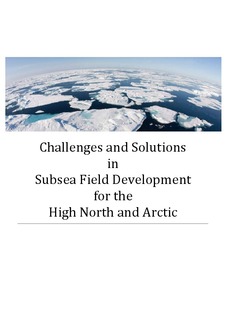| dc.contributor.author | El-Wardani, Riad | |
| dc.date.accessioned | 2013-09-24T09:24:22Z | |
| dc.date.available | 2013-09-24T09:24:22Z | |
| dc.date.issued | 2013 | |
| dc.identifier.uri | http://hdl.handle.net/11250/183016 | |
| dc.description | Master's thesis in Offshore Technology | no_NO |
| dc.description.abstract | Problem / Challenge
Estimates indicate that approximately 25% of the world’s unexplored hydrocarbon reserves lie beneath the depths of the Arctic regions, with around 1% (1.5 billion ton of oil equivalent) of that lying untapped under the depths of the Norwegian Barents Sea. Concurrently, the high north and Arctic are vaguely understood and lack of infrastructure in these areas makes it hard to gather sufficient data to be able to conduct detailed analysis. Furthermore, the distinct inhabitants and sensitive ecosystem make these regions extremely fragile and sensitive to change, which needs to be carefully considered by companies looking to explore for oil and gas in these areas.
This project reviews the currently identified challenges and by conducting hazard identification, failure mode and criticality analyses, different field development solutions are scrutinized. By ranking different best available and qualified technologies (BAQT), it enables engineers to narrow the analysis and go deeper into the details so that one day the untapped resources of the Arctic can be safely and sustainably harvested with the environment at the forefront of their considerations.
Project Scope
Project scope includes the review of currently identified and acknowledged challenges in the high north and Arctic regions specifically focusing on the Norwegian Barents Sea. This includes the characterisation of challenges and putting them into context as to why they pose threats on production systems. To complement the review of the latest field development concepts, a grid analysis helps highlight their strengths and weaknesses as well as their applicability to the high north and Arctic. Following, a hazard and failure mode identification analyses is carried out on the field development concept highlighted through the grid analysis before investigating best available and
qualified technology (BAQT) related to the concept. | no_NO |
| dc.language.iso | eng | no_NO |
| dc.publisher | University of Stavanger, Norway | no_NO |
| dc.relation.ispartofseries | Masteroppgave/UIS-TN-IKM/2013; | |
| dc.subject | field development | no_NO |
| dc.subject | subsea | no_NO |
| dc.subject | high north | no_NO |
| dc.subject | cold climate | no_NO |
| dc.subject | sea ice | no_NO |
| dc.subject | icing | no_NO |
| dc.subject | winterization | no_NO |
| dc.subject | polar lows | no_NO |
| dc.subject | iceberg | no_NO |
| dc.subject | HAZID | no_NO |
| dc.subject | BAQT | no_NO |
| dc.subject | subsea compression | no_NO |
| dc.subject | subsea boosting | no_NO |
| dc.subject | subsea processing | no_NO |
| dc.subject | offshore teknologi | no_NO |
| dc.subject | undervannsteknologi | no_NO |
| dc.title | Challenges and solution in subsea field development for the High North and Arctic | no_NO |
| dc.type | Master thesis | no_NO |
| dc.subject.nsi | VDP::Technology: 500::Marine technology: 580::Offshore technology: 581 | no_NO |
